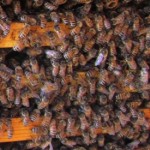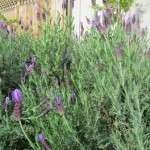Archive for the 'Uncategorized' Category
Poinsettia Season Has Arrived
When you see the ubiquitous poinsettia plants showing up everywhere, you know Christmas is near. The potted plant offers spectacular color during the Christmas season with displays of red, white, pink, purple, yellow, green, or variegated, depending on the cultivar.

Although orchids are the most popular potted plants sold in America, poinsettias clearly occupy second place. Over 100 different varieties have been cultivated and patented.
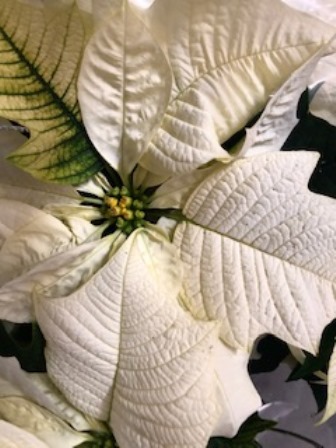
Indigenous to Mexico and Central America, poinsettia plants were once cultivated by the Aztecs. Today, the plant is much beloved because of its deep green foliage and flame-red bracts–the two colors most often associated with Christmas. Poinsettias have small yellow flowers known as cyathia. They protrude from each bunch of bracts and add to the beauty of the plant.
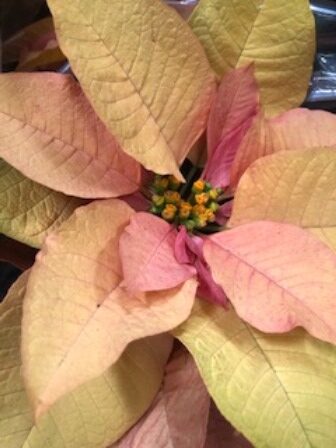
Unfortunately, many poinsettias plants are discarded after the holiday. If you are lucky enough to live in an agricultural hardiness zone with mild temperatures (for example, zones 9 through 12), you can grow your poinsettia outside in the garden. Otherwise, transplant it into a pot and follow the temperature, water, feed, and pruning guidelines below.
GROWING A POINSETTIA
- Keep the plant soil moist but ensure the roots do not sit in water or they will rot. If pot is wrapped in foil, poke some holes in the foil to ensure adequate drainage.
- Maintain a temperature of 65 to 70 degrees.
- For medium or large plants, trim back branches two to three inches to encourage lateral branching.
- Feed with a general purpose fertilizer mixed in water when you see new growth.
- Prepare to move the potted plant to the garden during the third week of June, choosing an area where the plant will get 4 to 6 hours of part sun daily. For plants that will remain potted, a bright, warm window works best.
- Put on gloves (to protect hands against the sap that can cause dermatitis) before handling the plant.
- To place in an outside garden, dig a hole three or four inches bigger than the pot.
- Place the plant in the hole and fill with good-quality soil mixed with peat moss or compost to ensure drainage.
- Water thoroughly.
- In autumn, shut out the light from the plant for 12 hours each day, using a bucket. This will stimulate the plant to begin to produce its spectacular color.
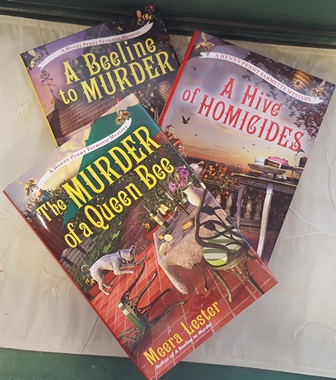
and in bookstores everywhere
If you enjoy reading about country living and gardening topics, check out my series of cozy mysteries. All are based loosely on my life as the proprietress of the real Henny Penny Farmette. A Beeline to Murder, The Murder of a Queen Bee, and A Hive of Homicides are all available online and wherever books are sold. Visit my author’s page on Amazon.com and also at my publisher’s site at https://www.simonandschuster.com/authors/Meera-Lester/2137649823 for information on my nonfiction books.
The Joy of Growing Iris
Nothing beats the joy of an early morning walk in a garden and seeing iris plants in full bloom. These beauties are easy to grow, vigorous reproducers, and deer resistant.
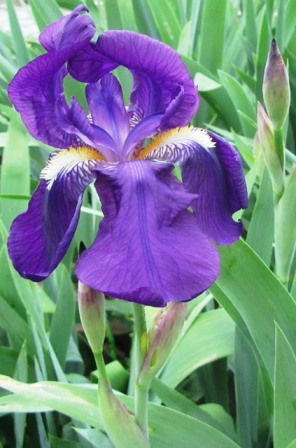
Iris need six to eight hours of sun each day. If you live in a hot climate, your iris will need some shade protection. They perform best in well-drained soil.
The best time of the year to plant iris seems to be late summer or early fall when the temperature does not fall below 40 degrees Fahrenheit.

The rhizomes of iris tend to spread, so you’ll want to divide the clumps every three to four years. The best time to divide them is about six weeks after flowering.
To divide, dig up the clump, pull the rhizomes (roots) from the sides of the mother plant and then plant the new rhizomes, burying them so that the roots are pointing down and the top foliage (even if you have cut it back to a few inches) is exposed. Cover with soil, tamp down, and water well.
Space the iris rhizomes at least one to two feet apart. Planting too close together reduces the number of blooms. There are many varieties of iris to choose for your garden; two of the most common types are Bearded iris and Siberian iris. Plant some of these beauties and experience the joy of seeing them bloom in your garden.

If you enjoy reading about gardening and country living topics, check out my series of cozy mysteries based on my life on the “real” Henny Penny Farmette. The novels are chocked full of tips on gardening, keeping chickens and bees, and growing heirloom vegetables and fruits.

Barnesandnoble.com, and other online bookstores
My novels and self-help, spirituality, and wellness books are offered online and everywhere books are sold. Check out my author’s page on Amazon and also on Simon and Schuster.com.–Meera Lester
Baking with Persimmons
Fall is the time when persimmons come to market. In general, you’ll see two different types. Fuyu is a squat-shaped, round fruit. Hachiya has a pear shape. Both fruits possess a bright orange color, thin skin, and leaves at the bottom when ripe.
Fuyu can be consumed at the crunchy stage like sliced apples in salad but you must not eat hachiya until it is soft and fully ripe because of its extreme astringency. You can slice off the top of Hachiya and eat it with a spoon like a soft pudding.
Turn your ripe persimmons into pulp before making baked goods such as bread, cake, and bar cookies. Nothing says autumn like this late autumn fruit in a lemon-drizzled bar cookie that uses the pulp of persimmons and chopped dates. In the recipe that follows, I used the Sunsweet brand of chopped dates.
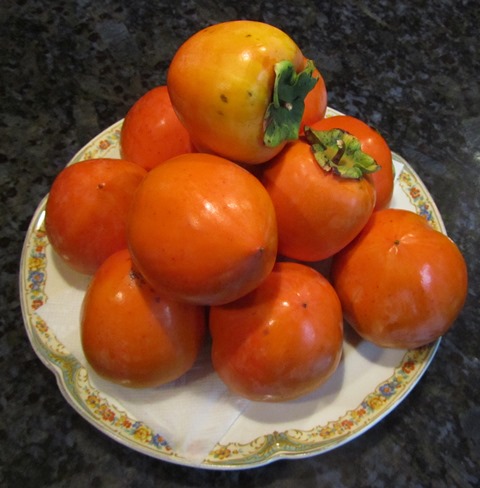
RECIPE for Persimmon-Date Bars with Lemon Glaze
Ingredients:
1 3/4 cups flour
1 teaspoon ground cinnamon
1 teaspoon ground nutmeg
1 teaspoon Kosher salt
1/2 teaspoon ground cloves
1 cup pureed persimmon pulp
1 1/2 teaspoon lemon juice (plus 2 tablespoons for glaze)
1 teaspoon baking soda
1 cup granulated sugar
1 cup finely chopped dates
1/2 cup vegetable oil
1 egg
1 cup confectioners’ sugar, sifted
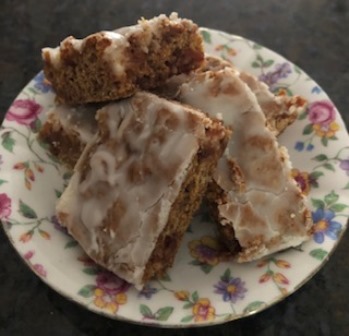
Directions:
Preheat oven to 350 degrees Fahrenheit. Grease and flour a 9 x 13-inch glass baking dish.
Mix together flour, cinnamon, nutmeg, salt, and cloves in a bowl.
In a separate bowl, thoroughly combine persimmon pulp, 1 1⁄2 tsp. lemon juice, and baking soda. Set aside.
Using a whisk, mix together granulated sugar, dates, oil, and egg in a large bowl. Add dry ingredients and persimmon mixture. Stir until just combined and then pour mixture into the prepared baking dish. Use a spatula to flatten and smooth the top of the cookie dough.
Bake 25 minutes until lightly browned. Remove from oven and let cool for five minutes while you make the glaze.
To make the glaze, whisk together 2 tablespoons of lemon juice and confectioners’ sugar until smooth. Pour the glaze in zigzags across the bar cookie and then smooth out the glaze with a spatula. When the bar cookie has hardened, cut into rectangular bars or diamond shapes.

Country Fresh Peach Cobbler
Ripe peaches, widely available throughout summer, are delicious in cobblers, pies, and pancakes. They are scrumptious in spreads like jam for toast, on pound cake drizzled in brand or a fruit wine, or over warm bread. Alternatively, pile ripe peaches into a pandowdy, tart, galette, or crostini (the French and Italian versions of a rustic one-crust pie with edges folded over to hold in the fruit).
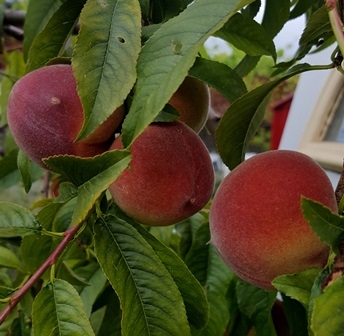
Folks in the Midwest where I grew up enjoy peach cobbler best when served warm with rich vanilla ice cream or piled high with homemade whipped cream. Of course, this cobbler is especially tasty served cold when flavors have time to marinate. To ensure freshness, always refrigerate.

For this peach cobbler recipe, you’ll need about two and one-half pounds of fresh, ripe peaches. Gather your tools, bowls, and ingredients. Preheat the oven to 350 degrees Fahrenheit.
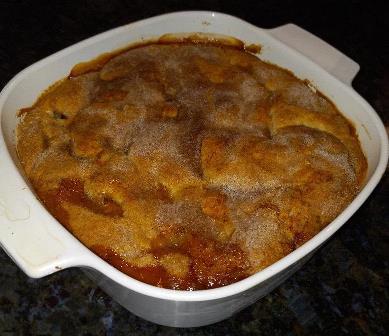
RECIPE: COUNTRY FRESH PEACH COBBLER
Ingredients:
1 cup flour
2 teaspoons baking powder
1/2 cup sugar
6 Tablespoons cold, unsalted butter, cut into cubes
1 large egg, lightly beaten
1/4 cup Half & Half
2 1/2 pounds fresh peaches (peeled, pitted, and sliced)
2 Tablespoons fresh lemon juice
2 Tablespoons apricot preserves
1 teaspoon ground nutmeg or mace and 1/2 teaspoon ground cinnamon for peach filling
1/2 teaspoon ground cinnamon mixed with 2 Tablespoons sugar for topping
Directions to Make Crust
Divide sugar into two equal portions. In a large bowl, pour in the flour, baking powder, and one portion of the sugar. Mix the ingredients until thoroughly combined. Cut four tablespoons of the butter into cubes. Drop pieces of butter into the dry ingredients. Using a pastry cutter or your fingers, integrate the butter into the dry ingredients until the mixture is crumbly. In a separate bowl, beat together egg and Half & Half. Slowly pour this into the dry flour mixture and mix until the dough is moistened, not wet. On a piece of plastic wrap that has been sprinkled with a little sifted flour, shape the dough into a ball, cover with plastic wrap, and refrigerate for 15 minutes.
Directions for Preparing the Peaches
In a medium-size bowl, mix the peeled, pitted, and sliced peaches with lemon juice, nutmeg (or mace), 1/2 teaspoon cinnamon, apricot preserves, and the remaining portion of sugar. In a 1 1/2 quart baking dish, pour in the peach filling. Cut the remaining butter into pieces and add to the peaches.
Directions for Assembling the Cobbler.
Roll out the cobbler dough and place it so that it covers the peaches and stretches to the edge of the baking dish. Seal by crimping the dough around the edges of the dish. Cut vents into the dough. Then sprinkle the cinnamon and sugar mixture over the top of the crust. Bake 30 to 35 minutes. Remove when crust has browned and let cool. Serve with ice cream or whipped cream.
If you enjoy reading about country living, check out the novels based on my farmette life: A Beeline to Murder, The Murder of a Queen Bee, and A Hive of Homicides. All are available from Amazon, Barnes & Noble, and other online retailers as well as bookstores everywhere.

Grow Food in Cool Weather
If you are lucky enough to live in an area where gardening can be done through spring, summer, and fall, September is the time to start looking in local nurseries for plants that grow in cooler weather. Here are some tips to get a quick start on fall planting of cool season crops, including brassicas, root crops, vegetables, and herbs.
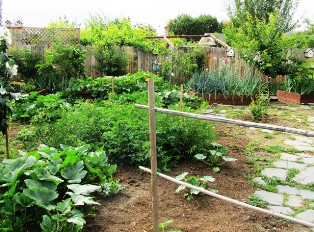
Keep in mind that all new seedlings require well-drained soil. For leafy Brassicas, incorporate some agricultural lime into the soil to get them off to a good start. For leafy plants like Swiss chard, make sure to plant in full sun in soil that is rich in humus and well draining.
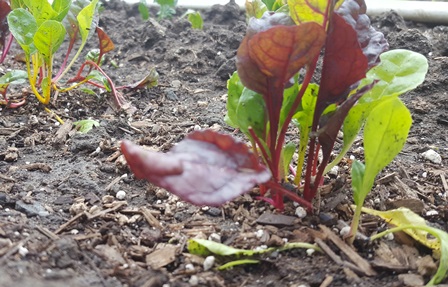
If you are planting broccoli, cabbage, or other brassica crops that attract aphids, plant some sweet alyssum. The tiny flowers attract syrphid flies, whose larvae consume the invading aphids.
Suitable for autumn planting:

- Brassicas (bok choy, broccoli, Brussels sprouts, Chinese cabbage, Napa cabbage, Savoy cabbage, cauliflower, kohlrabi or German turnip)
- Root crops (turnips, radishes, beets, carrots, and rutabagas)
- Leafy Brassicas (arugula, collards, horseradish, kale, mustard greens,spinach, wasabi, watercress)
- Cool season vegetables (broad or Fava beans, celery, garlic, leeks, peas, scallions or spring onions, Swiss chard)
- Herbs (borage, chives, chicory, cilantro/coriander, chamomile, chervil, dill, fennel, mint, oregano, parsley, rosemary, and sage)
If you enjoy reading about gardening and country topics, check out my cozy mystery novels chocked full of delicious recipes and tips for country living–A BEELINE TO MURDER, THE MURDER OF A QUEEN BEE, and A HIVE OF HOMICIDES. All are available from Amazon, Barnes & Noble, and other online outlets and bookstores everywhere.
See, https://www.amazon.com/s?k=Book%2BMeera+Lester&ref=nav_bb_sb

Grow Some Tomatoes This Summer
The tomato is the favorite plant of backyard gardeners for good reason. It’s the perfect addition to summer salads, soups, pizzas, and a host of other delicious culinary creations. Plus, tomatoes are easy to grow.
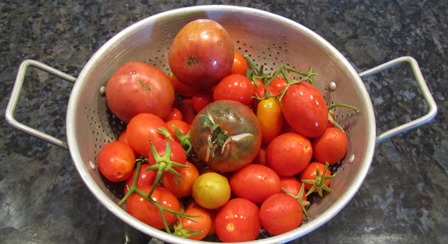
Tomatoes are grouped as either determinate or indeterminate. Determinate tomatoes will flower and then produce fruit. Fruit and flower mature simultaneously. Then, the plant is done. This type of tomato is perfect for growing in a container because it remains bushy and rarely needs staking.
Indeterminate tomatoes grow throughout the season, perpetually flowering and setting fruit. The plant produces fruit on vines that require staking for support. Many backyard gardeners choose this type of plant because it keeps on producing.
Tomatoes require fertile soil with good drainage to perform well. They also need eight hours of direct sunlight in most parts of the country except in the areas where summer temperatures can hover between 85 degrees Fahrenheit up to triple digits. For areas with such sizzling hot days, shade tomato plants between 10 A.M. and 2 P.M. (when flowering and pollinating take place), using a shade cloth over a frame.
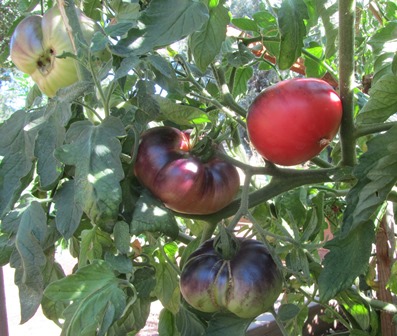
Control tomato pests such as slugs and snails by picking them off and disposing. Tomatoes are also subject to attacks by sucking insects like aphids and whitefly. Try spraying with dish soap and water or hang sticky tape.
Heirloom tomatoes have been favored for generations because the seed can be saved and used for a future garden. Plus the flavors, colors, and textures are quite diverse. Some heirloom varieties to try include (but are not limited to) Brandywine, an Amish heirloom that features a deep red color and meaty flesh (there’s also a yellow Brandywine tomato). Cherokee Purple, dated to before 1890, produces large fruit with true, old-fashion tomato flavor. Costoluto Genovese is an Italian coastal tomato with dark red flesh and lots of ribbing. Hillbilly comes from the hills of West Virginia and features red striping and mottling on its yellow-orange skin. Mortgage Lifter is an old favorite with few seeds and luscious pink flesh. Stupice, from the Czech Republic, produces golf ball-size, highly flavorful fruit.
Fruit Spreads Make Life a Little Sweeter
On the Henny Penny Farmette, we care for a small orchard of fruit trees. Each spring, summer, and fall, we harvest fruits to make sweet spreads. Whether spooned onto warm bread or waffles, scooped onto ice cream, or sandwiched between cookies, our homemade spreads offer a tasty reminder of the seasons of warmth.

There are lots of different types of spreads, including chutneys, compotes, conserves, fruit butters, jams, jellies, and preserves. Each type has special characteristics. The following lists outline some of the differences between these delicious spreads.

The Three C’s–Chutneys, Compotes, and Conserves
Chutneys are condiments that offer a variety of textures, from smooth to chunky, due to the type of fruit used as well as the blend of sugar, spices, and vinegar. The addition of chili peppers adds heat.
Compotes are often composed of fruit, either whole or in pieces, in a sugar-water syrup that includes spices.
Conserves are flavor- and texture-enhanced by adding to the jam such ingredients as dried fruit and nuts.

Preserves are spreads that include chunks of fruit cooked into the jam mixture. A marmalade is a type of preserve. We like marmalade made from citrus such as naval and blood oranges, lemons, and kumquats. You can make a lovely berry preserve by combining different types of berries with a sparkling juice, lemon zest, and sugar. Or, try cranberries and oranges for a tasty preserve for morning toast.
Fruit butters are spreads that have been cooked until all fruit has been incorporated in a buttery consistency. These blends of fruit and spice make them particularly sweet.
Jellies are made mainly from the juice of fruit cooked with sugar and pectin (to thicken). We make jelly from our late summer pomegranates, but your options are expansive when you consider all the types of fruits, flowers (yes flowers, like violet and lavender make wonderful jellies), and fruit juices that can be combined into a delicious jelly.
If you enjoy reading about gardening, preserving produce and fruits, and other country living topics, check out my Henny Penny Farmette series of cozy mysteries. The novels and my self-help, wellness, and spirituality books are available online and everywhere books are sold. See, https://www.amazon.com/Meera-Lester/e/B001JP835E%3Fref=dbs_a_mng_rwt_scns_share
Why I Choose to Plant Heirloom Seeds
Here in Northern California, gardeners are filling the local nurseries in search of seeds and seedlings to plant in their gardens. Many choose vegetables like tomatoes. The options are either hybrid and heirloom types.

Hybrid seed has been bred for higher yields and to be more disease resistant. Heirlooms are seeds that have been around for generations and are still popular because they perform well. Heirlooms have not been hybridized or genetically modified (non GMO).
Last year, I planted some heirloom yellow Brandywine cherry tomatoes. The pretty leaves looked more like potato than tomato leaves. The fruit was delicious and the plants were super productive.
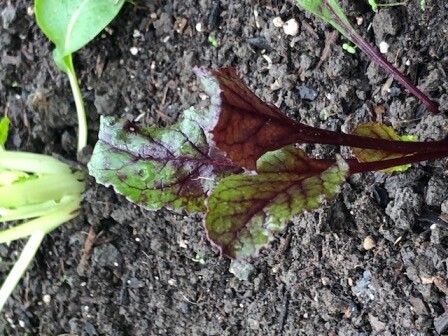
The rains came before I got composting done on that bed. Winter arrived and then spring again. The seeds leftover from the previous summer garden sprouted and gave me hundreds of new yellow tomatoes for this year’s garden.
I love working with heirloom seeds. Because you can harvest seeds (or enjoy some plants that re-seed), you save money. You can collect seeds from you best specimens for a future garden. Hybrid seeds are often patented and more expensive. The seed company owns the right to those seeds.
Heirlooms are open pollinated and offer an incredible diversity in color and size of produce. These open-pollinated plants are often attractive to Earth’s pollinators like bees and butterflies. Pollinators boost production in the garden. Heirlooms are our great-great grandparents’ seeds and have stood the test of time for flavor, production reliability, and growth dependability. You have a choice. Why not try heirlooms this year?
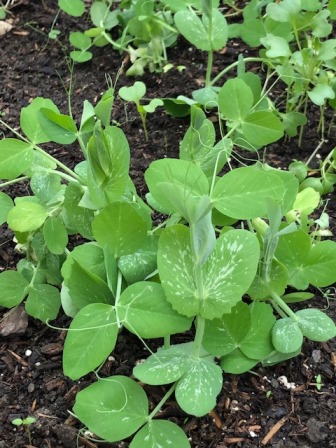
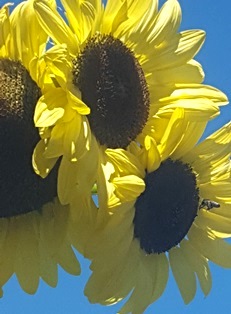
If you enjoy reading about gardening and country life, check out my Henny Penny Farmette series of cozy mysteries, including A BEELINE TO MURDER, THE MURDER OF A QUEEN BEE, and A HIVE OF HOMICIDES. These cozy mystery novels and the more than two dozen health and wellness books I’ve written are available online and everywhere books are sold.
See, https://www.amazon.com/Meera-Lester/e/B001JP835E%3Fref=dbs_a_mng_rwt_scns_share
Swarms of Honeybees Mark an Early Start to Spring
On my birthday in late March this year, I noticed a large swarm of honeybees in my neighbor’s yard. The weather was warm and perfect for the overpopulated hive to release some of its citizens to find a new home with their new fertile queen.
Then on April 8–Easter Sunday, my own Italian honeybees swarmed. Our hive had made it through the winter although the bees had battled hive beetles. But just as hubby and I were on ladders that Easter afternoon building a new trellis for our grapes, I heard the low hum of thousands of bees lifting skyward.
Sure enough, the new swarm had emerged from our hive. We dropped our drills, screws, and lumber. He banged on cooking pot with a wooden spoon (to disorient the bees and encourage them to land in a nearby tree) while I set up the extra hive box with empty frames.
Suited up in beekeeper gear, my hubby clipped a couple of branches from the pin oak tree to make it possible to do a hard shake on the one limb the bees had coalesced around. He placed the prepared hive box beneath the tree. Our beekeeper neighbor joined us and helped. Then, a hard shake and boom…the entire colony dropped into the hive box.
We waited until after dark to ease the hive box lid in place and then take the entire box to its permanent location in a sunny, dry spot in the garden.
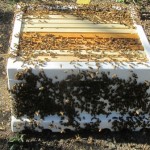
A hive box without its lid. The bees do a waggle dance to tell the bees still in the air that this is their new home
The work on the trellis that will serve as our grape arbor was nearly complete when the swarm occurred. Now the finishing touches will have to wait for another day.
Backyard Herbal–Hair Rinses and Hot Oil Treatments
In college, I often washed my then waist-long auburn hair with apple cider vinegar to keep the locks healthy and shining. And years ago, I discovered the decadent pleasure of a hot rosemary oil treatment and scalp massage that uses lavender oil.
If you grow your own herbs, making hair-care products couldn’t be easier.
The following are simple recipes you can make with home grown herbs and essential oils available in health food stores.
Apple Cider Vinegar Rinse Recipe: 4 cups of warm water to 1 cup apple cider vinegar. After you’ve washed the shampoo out of your hair, use the vinegar water as your final rinse.
Alternatively, you could add a couple of ounces of your favorite herbs like lavender, lemon balm, chamomile, or rosemary sprigs along with scented essential oils to impart shine and fragrance to your hair. Rosemary is also good for promoting hair and scalp health.
Rosemary Rinse Recipe: 4 cups of boiling water poured over 2 ounces of rosemary springs. Let set overnight under a lid or cover. The next day, strain out the rosemary sprigs and add to the liquid 10.5 ounces of apple cider vinegar and 10 drops of rosemary essential oil. Wash your hair, rinse, and as a final step pour through your hair the rosemary rinse.
For dry hair and scalp, create an oil treatment that you can do once every three weeks or a on a monthly basis. You’ll need rosemary, lavender, and a bit of tea tree oil (which possesses chemicals that may kill bacteria and fungus and reduce dandruff).
Hot Herbal Oil Treatment: 2 drops each of the following herbal oils–rosemary, tea tree, lavender–in 6 tablespoons of coconut oil. Thoroughly combine in a dark bottle, seal, and store. When you are ready for your hot oil treatment, sparingly apply the oil to strands of dry hair until all is lightly coated, not saturated. Cover with a hot towel for 15 to 20 minutes. Remove the towel and wash with shampoo as usual.
________________________________________________________
If you love all things natural, country, and homemade AND you enjoy a cozy mystery, check out my novels available online at Amazon.com, Barnes & Noble, Walmart, and other retail outlets as well as in bookstores everywhere.
For my newest novel, A HIVE OF HOMICIDES, click on the link: http://tinyurl.com/ya5vhhpm
 Facebook
Facebook Goodreads
Goodreads LinkedIn
LinkedIn Meera Lester
Meera Lester Twitter
Twitter







